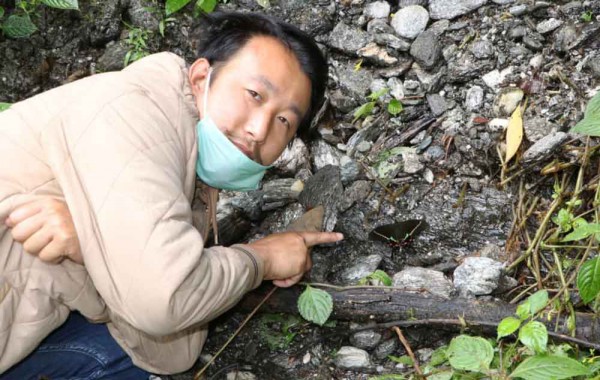




















Saturday, Jun 20, 2020 12:30 [IST]
Last Update: Saturday, Jun 20, 2020 06:49 [IST]
BIJOY GURUNG
GANGTOK: A young butterfly enthusiast is on a quest to chronicle the butterflies fluttering in his native Dzongu region and give them indigenous names in Lepcha language.
Dzongu, a Lepcha protected area in North Sikkim, is a bio-diversity hotspot and its richness in butterflies had already been recorded way back in mid-19th century by the famous British botanist and explorer J.D. Hooker during his Sikkim expedition.
Hooker, in his Himalayan Journals published in 1885, had fawned over the discovery of ‘amazing quantities of superb butterflies’ in Dzongu.
Over the years, top lepidopterists from India have been reaching Dzongu and preparing a checklist of butterflies found in Dzongu and scientifically classifying these majestic insects. The names runs some distance, for example, ‘Euthalia anosia saitaphernes: Sikkim Grey Baron’ (Family Nymphalidea) which is a regal and rare butterfly spotted at Sangkhalang, Upper Dzongu last October.
Meanwhile, for the Lepchas in Dzongu, every butterfly is taken as a noun and called ubiquitously as ‘Thamblyok’ in Lepcha language.
Sonam Wangchuk Lepcha wants to upgrade this ‘Thamblyok’ noun to a proper noun in Lepcha language so that each butterfly species in Dzongu is recorded with an indigenous name.
The 32-year-old hails from Noom Panang, locatedbetween Passingong and Sangkhalang, Upper Dzongu. He took up the study and photography of butterflies at his native place from May 6, 2016. During his field trips to every nook and corner of Dzongu in these four years, it dawned upon him that there is no local name for the butterfly species endemic in Dzongu.
“While researching in the villages, I found out that we do not have local names for the butterfly species. It is simply called as ‘Thamblyok’ and there are no other names. In contrast, we have local names for other flora and fauna in Dzongu but butterfly is left at ‘Thamblyok’. It gave me much to think over,” said Sonam Wangchuk to SIKKIM EXPRESS.
Sonam Wangchuk has so far photographed and recorded around 200 butterfly species in both lower and upper regions of Dzongu. He contributes his findings online to national butterfly interest groups at ifoundbutterflies.org where it is uploaded and recorded under his name. Experts also help the Dzongu youth in identifying those butterflies unfamiliar to him.
“I want to continue to follow butterflies in Dzongu for next 4-5 years and prepare a comprehensive guide book. There so many butterflies which I have not been able to capture in my camera. They flew away before I could click. Besides the documentation, I also intend to give individual Lepcha names to the butterflies of Dzongu which I record. I am working on how to go about it and how to arrive at a proper Lepcha nomenclature for the butterflies of Dzongu,” said Sonam Wangchuk.
“Our elder generation introduced us to butterflies as ‘Thamblyok’. Tomorrow, our coming generation should be able to say what kind and which ‘Thamblyok’ is found in Dzongu,” added the Dzongu youth.
Nosang M. Limboo, an authority in butterflies from Sikkim, has been guiding Sonam Wangchuk in his pursuit of Dzongu butterflies.
Speaking with SIKKIM EXPRESS, Nosang welcomed the aim of Sonam Wangchuk to document and domicile the endemic butterflies with indigenous Lepcha names.
“Our ancestors, especially the Lepchas, were very close with nature and had names for almost everything found in nature around them. So it is bit strange that there is no individual names for butterflies but coming to this day, it is very interesting and a good thing that a Lepcha youth is trying to give Lepcha names to the Dzongu butterflies. If this happens, it will add up to faunal literature. Not just the Lepchas, if other Sikkimese communities like Limboos, Nepalis and Bhutias can name the butterflies in their languages, it will be a huge contribution to the coming generation,” said Nosang.
Nosang, who hails from Darap in West Sikkim, is the author of the ‘Flying Pearls of Sikkim Himalaya’, a pictorial guide book on the butterflies of Sikkim which was published in 2013. He believes that local youth like Sonam Wangchuk should be supported by the people for preservation and promotion of Sikkim’s flora and fauna.
“Sonam Wangchuk Lepcha has been working very hard in Dzongu regarding the documentation of butterflies there. He needs to be supported by the like-minded people in Sikkim. The department concerned should support youth like him. He has recorded rare butterfly species and this is a big contribution to the State and we really need to support such youth,” said Nosang. He added that he has been working with Sonam Wangchuk since the entry of Dzongu native into the butterfly world. I have been putting all possible guidance to him and in this matter, I will do everything possible to support him, he said.
On his part, Sonam Wangchuk says that it is a responsibility of the local people to document the natural flora and fauna found in their villages. Otherwise, their future generation would have no idea, he said.
“I will work on my pursuit for 4-5 years and after that come up with a guide book on Dzongu butterflies with help of seniors. The objective is that the butterflies endemic to Dzongu are documented for the future generation.”
Sonam Wangchuk, who is planning to start a homestay in his village, believes that the butterfly wealth of Dzongu can supplement the eco-tourism potential of the area. If we can document the diversity of butterflies found in Dzongu, many butterfly lovers from outside the State could come here and consequently, benefiting the local people and homestays, he said.
Homestay tourism in Dzongu is catching up with tourists coming to enjoy the natural attractions of this isolated region.
Sonam Wangchuk recalled the first day when he became enchanted with the butterflies.
“It was on May 6, 2016, when my interest in butterflies started. That day, I had recorded 40-50 butterflies at Namprikdhang, Upper Dzongu and prepared a checklist of my findings. I thought maybe tomorrow I can get some more new species and went to Namprikdhang again. It gradually became an interest and now a passion.”
In search of butterflies, Sonam Wangchuk has criss-crossed the entire Dzongu region, a tough proposition considering the scattered settlements, lack of proper road network, multiple rivulets and dense forests. He has even trekked to Tholung, the remotest corner of Dzongu in search of ‘Thamblyok’ under the base of Mount Khangchendzonga.
His reward has been a growing catalogue of butterflies, some of which are rare species and some have been spotted again after several years.
Nosang shares that the early records of Dzongu as a butterfly hotspot can be found in the ‘Himalayan Journals’ from Hooker in 1855. In the book, Hooker particularly mentions about Dzongu and his sighting of ‘amazing quantities of superb butterflies seen everywhere sailing majestically through the still hot air fluttering fluttering from one rock to another, especially loving to settle on the damp sand of the river edge where they sat by thousands, dancing themselves with rocking motion’, he quoted from the book.
“Dzongu is a butterfly hotspot because of its elevation which starts from 300 m-400 m altitude and goes up to 5,000 m or we can say even up to Mount Khangchendzonga (8,586 m). Dzongu has all kinds of elevation and there is variety in vegetation also which means variety in species,” said Nosang.
On his part, Nosang has recorded around 400 species of butterflies in Dzongu.
“The difference I find in Dzongu and other parts of the country is that the butterflies I see in Dzongu are much healthier than those found in other parts of State and country. The same butterflies are found elsewhere but those found in Dzongu are healthier and stockier,” he shared.
Sonam Wangchuk has been spending around 15-16 days a month to find the elusive species of butterflies.
Asked why he is marching up and down the hills of Dzongu chasing butterflies, Sonam Wangchuk said: “To be frank, butterfly is a beautiful thing and appealing to the eye. Even if one is not interested in butterfly, he or she will be delighted when a butterfly is spotted. If they can think like that, imagine what feeling it invokes among those interested in butterflies. For me, it is also a personal mission to record butterflies in Dzongu because we have it.”
Nosang explained that butterflies are indicators of climate change and also play an important role in the ecosystem as it comes in the food chain of birds and reptiles.
“It is one of the major agents of pollination and we all know how important the process of pollination is. Butterflies are indicators of climate change. If there is shifting of butterflies from its natural altitude then we can assume that there have been some changes in the environment. Hence, study of butterflies would be a huge contribution to science actually. Many Zoology students are choosing study of butterflies these days,” he said.
Meanwhile, Sonam Wangchuk is persisting in the natural lab of butterfly at Dzongu despite amused looks from fellow villagers.
“It feels awkward and embarrassing sometimes when I go around carrying a camera in the villages. I tend to get funny looks from the people while searching and taking photos of butterflies. But I feel that if you are passionate about something then you must be able to digest such responses. I feel that I am doing something positive for Dzongu. I have recorded some rare butterfly species and I feel that it is a big achievement for a local to do so in his own place. It gives me a sense of local ownership,” concludes Sonam Wangchuk.
